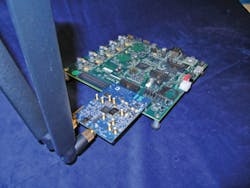Software-defined-radio (SDR) technology provides the extreme flexibility of software control of radio parameters. However, because it is so different from traditional analog, mixer-based radio architectures, knowing how to optimally incorporate an SDR in a commercial or military communications application requires something of a learning curve. To help expedite the process, Analog Devices and Avnet have teamed on an SDR kit that provides an assembled radio base board using Analog Devices’ AD-FMCOMMS1-EBZFMC wireless communications module, application software, source code, and a number of evaluation tools.
The Zynq™-7000 SDR kit (see figure) from Analog Devices consists of the Avnet ZedBoard 7020 base board; the AD-FMCOMMS1-EBZFMC communications mezzanine-card module [which employs a field-programmable gate array (FPGA) from Xilinx (www.xilinx.com)]; a model-based design kit from The MathWorks (www.mathworks.com); HDL source code; Linux drivers; Gerber files; reference designs; schematic diagrams; and a pair of MMCX-to-MMCX coaxial cables. The FMCOMMS1-EBZ includes an analog front-end which can be quickly configured to operate with a variety of compute-intensive FPGA-based applications. It is designed for use with the Xilinx Zynq® Software-Defined Radio Kit for full flexibility in developing complete SDR-based communications products.
The SDR kit reduces development risk and time; it is suitable for wireless infrastructure, as well as for military and industrial radios. Featuring a 200-MHz bandwidth that can be tuned across a bandwidth of 400 MHz to 4 GHz, it allows operators to bypass the RF section for baseband sampling. It is also well suited for multiple-input, multiple-output (MIMO) antenna configurations. The SDR kit builds on the performance available from the AD-FMCOMMS1-EBZFMC, which is populated with a number of high-performance components from Analog Devices. These components include a 6-GHz model ADL5380 demodulator, a 6-GHz model ADL5375 modulator, a model AD9122 16-b digital-to-analog converter (DAC), and a model AD9643 14-b analog-to-digital converter (ADC).
The SDR board and AD-FMCOMMS1-EBZFMC mezzanine card operate with four functional partitions: the transmit signal path, the receive path, clock generation and management, and register access. For transmission, the card converts in-phase (I) and quadrature (Q) baseband signals to modulated RF/microwave signals. The model AD9122 interpolates this data and applies frequency translation to the baseband signals. A complex analog output from the AD9122 DAC then feeds a model ADL5375 quadrature modulator where it is translated to the required RF output frequency. Following an image-reject filter, the signal is boosted by 20 dB through a model ADL5602 amplifier with 4-GHz bandwidth. The amplifier provides RF outputs to +7.5 dBm. Signals for the AD9122 DAC are generated either by an internal direct-digital synthesizer (DDS) or via external memory.
Upon receiving a signal, the card converts an RF signal to complex I and Q signal components. The RF signal is demodulated by the model ADL5380 demodulator to achieve an intermediate-frequency (IF) signal from 50 to 200 MHz. This I/Q IF signal is then filtered and passed to the AD8366 variable-gain amplifier (VGA), which provides as much as 15.75 dB gain. Following additional filtering, the signal is digitized with the AD9643 14-b ADC. The system can derive a clock signal from an on-board crystal or crystal oscillator at 50 MHz or from the FPGA. Multiple boards can be kept in tight synchronization for MIMO applications, provided that the slave boards use the clock signals from the master board.
The Zynq-7000 SDR kit is supplied with operator’s manuals, software, and guidance to help a designer achieve the desired results from the kit. The kit includes the ISE{REG}Design Suite:WebPACK{TM} edition from Xilinx with a Chipscope Pro license node-locked to the embedded Xilinx XC7Z020FPGA. The model-based design kit and evaluation tools from MathWorks help to quickly move conceptual designs to working code for the SDR kit. The kit, which includes two Fourth-Generation Long-Term-Evolution (4G LTE) antennas for use from 2500 to 2700 MHz for those working in cellular systems, should certainly help to speed the educational process for any engineering interested in building on an SDR architecture.
Analog Devices, Inc., 3 Technology Way, Norwood, MA 02062; www.analog.com, Avnet Electronics Marketing, 2211 S. 47th St., Phoenix, AZ 85034; (800) 408-8353, www.avnet.com.
About the Author
Jack Browne
Technical Contributor
Jack Browne, Technical Contributor, has worked in technical publishing for over 30 years. He managed the content and production of three technical journals while at the American Institute of Physics, including Medical Physics and the Journal of Vacuum Science & Technology. He has been a Publisher and Editor for Penton Media, started the firm’s Wireless Symposium & Exhibition trade show in 1993, and currently serves as Technical Contributor for that company's Microwaves & RF magazine. Browne, who holds a BS in Mathematics from City College of New York and BA degrees in English and Philosophy from Fordham University, is a member of the IEEE.
